Galangae, Galangal, Gao Liang Jiang 高良姜
Gao Liang Jiang (‘High Mountain Ginger’) (TCM)Kulanjana (Ayurveda)
Perarattai (Siddha)
Khulanjaan (Unani)
Don gra དོང་གྲ (Tibet)
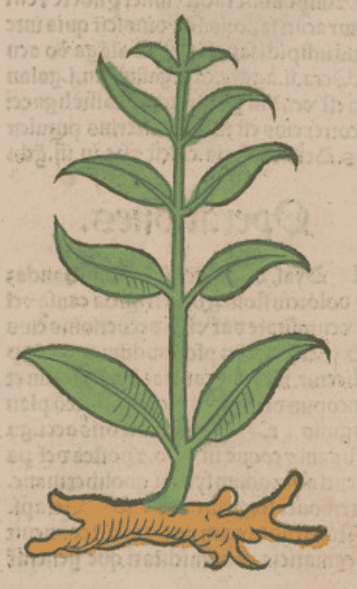 Ortus Sanitatis, Meydenbach, 1491
Ortus Sanitatis, Meydenbach, 1491 |
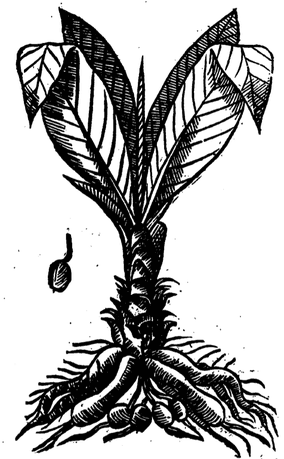 Parkinson, Theatrum Botanicum, 1640
Parkinson, Theatrum Botanicum, 1640 |
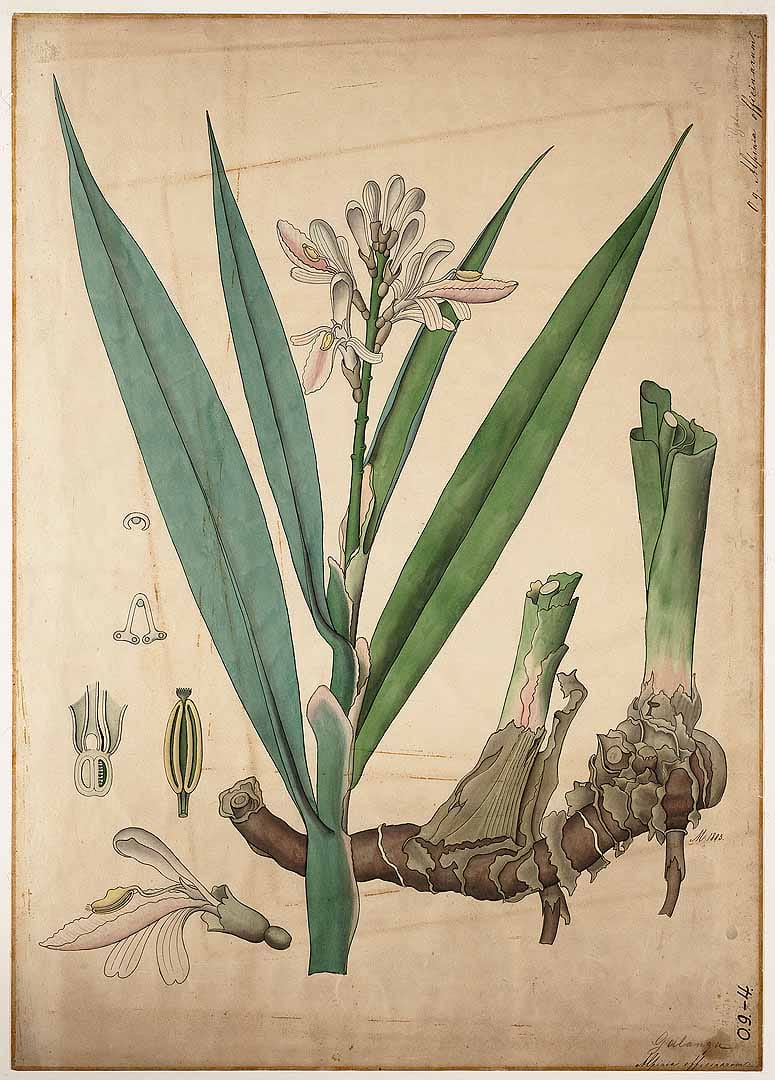 Lesser Galangal, Alpina officinarum
Lesser Galangal, Alpina officinarumBotanische wandplaten (1904–1914)
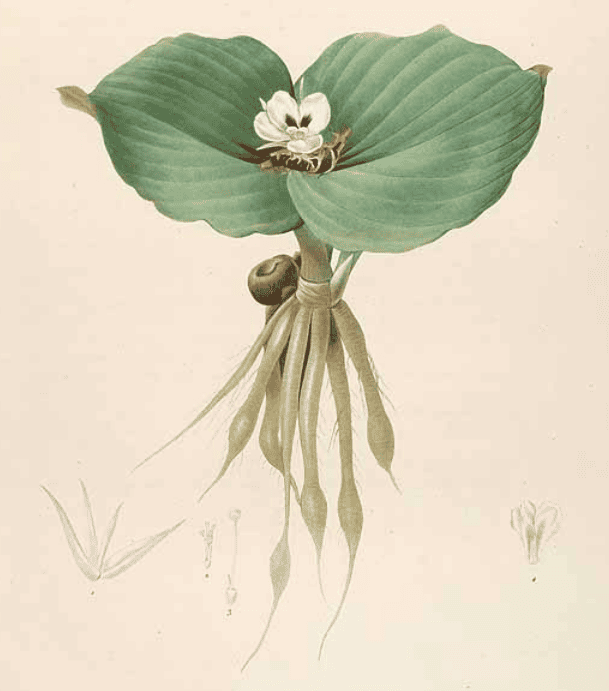 Kaempferia galanga
Kaempferia galangaRedouté, P.J., Les Liliacées, (1805-1816
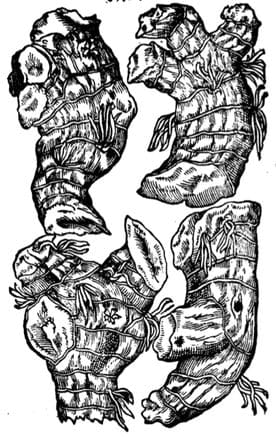
|

|
Herbarium, Matthioli (Polish), 1596
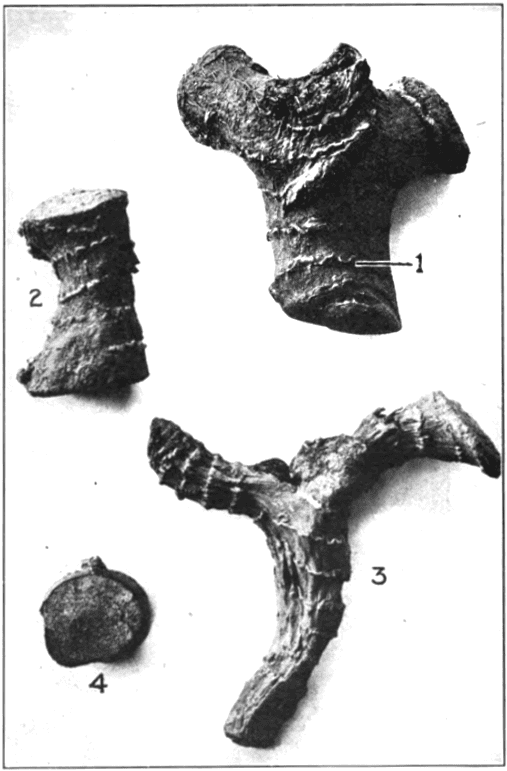 ALIPNA
ALIPNA1. Annulate, wavy leaf bases or scars. 2. Simple rhizome. 3, Branched rhizome.
4, Transverse section of rhizome showing scattered circular conducting strands.
Squibb’s Atlas of the Official Drugs, Mansfield, 1919
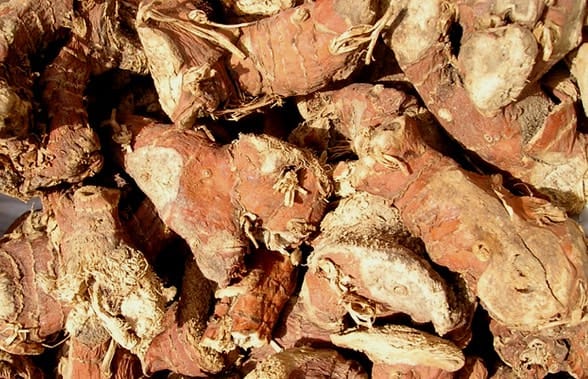 Galangal roots (Alpina) used in Tibetan Medicine (Dharamsala, 2009)
Galangal roots (Alpina) used in Tibetan Medicine (Dharamsala, 2009)Botanical name:
A number of plants have supplied ‘Galangal’:
- Greater Galangal: Alpina galanga (syn. A. calcarata, Maranta galanga, Languas galanga); Kulanjana (Ayurveda); Khulanjaan (Unani); Da Gao Liang Jiang (TCM); Don gra (Tibetan)
- Lesser Galangal, Chinese Ginger: Alpinia officinarum; Gao Liang Jiang (TCM); Don gra (Tibetan); Ayurveda and Unani also recognise this as the small variety of Greater Galangal and name it such.
- Kaempferia Galanga; Kaempferia galanga; Sga skya (Tibetan); Sugandha-vacha (Ayurveda)
Parts used:
Root
Temperature & Taste:
Very Warm (Lesser is hottest), dry. Pungent, aromatic.
“It is Hot and Dry in the Second degree”. (Avicenna)
Classifications:
2H. CARMINATIVE. 2Q. ANODYNE. 2S. STRENGTHENING
3F. LITHONTRIPTIC. 3I. APHRODISIAC. 3K. EXPECTORANT. 3M. ARTHRITIC
4c. CARDIAC. 4e. STOMACHIC
TCM:
M. Warm to Expel Cold
Uses:
1. Warms the Stomach, Eases Pain:
-Abdominal Pain, Vomiting, Dyspepsia, Gastralgia, Hiccup, or Diarrhea from cold.
-It helps colic by clearing intestinal wind.
-prevent attacks of the Gall Bladder after heavy meals
-Sea-sickness.
2. Warms the Kidneys, Promotes Urine:
-beginning stages of Edema
-Gravel, Stones and to promote Urine when obstructed by Cold.
–Salmon said it ‘Stirs up Lust’; classed as an Aphrodisiac in Unani and Ayurveda.
-used for Diabetes in India.
-’excellent against the Rickets in Children’. (Salmon)
3. Warms and Moves the Blood, Eases Pain:
-promote Menstruation when painful and blocked by cold.
-Chest pain, Angina Pectoris and ‘Palpitations of the Heart’ (Salmon)
-said to prevent Heart attacks.
4. Stops Wind, Clears Phlegm and Damp, Revives the Senses:
-Vertigo, Dizziness, Headache, Migraine and Fainting
-Deafness from Catarrh
-diseases of the Brain, Nerves and Senses caused by Wind and Phlegm.
-‘The smell of it strengthens the Brain’ (Gerard)
-classed as an exhilarant in Unani medicine
-used for Fatigue in Europe; likewise used for Nervous Debility in Ayurveda.
5. Clears Phlegm, Stops Cough:
-Coughs, Colds
-spasmodic Coughs and Asthma, Whooping, Cough, Bronchitis (West, Ayurveda, Unani)
6. Used for Snake Bite.
7. Externally:
-the fine powder is rubbed on the tongue for Stammering. (Unani)
Dose:
Decoction: 3–9 grams
Powder: 1–3 grams
Comment:
The different Galangal varieties are used similarly, and are similar in nature to Ginger. In Tibetan Medicine Kaempfera Galangal (Sga skya) is used for Wind-Phlegm disorders while Lesser Galangal (Don gra) increases Appetite; all increase body heat and warm digestion and circulation.
Correctives:
1. Aniseed
2. White Sandalwood
3. Tabasheer
4. Tragacanth (Unani)
Substitutes:
1. Cubebs (Unani)
2. Cinnamon. (Unani)
3. Ginger; Ginger with one-third Valerian added
Preparation:
1. Galangal is dry stir-fried, or Stir-fried with Earth, to increase its effect of warming the Stomach and stopping Diarrhea.
Main Combinations:
Galangal & Cyperus
Calamus & Galangal
1. Cold diseases of the Head, Heart, Stomach, Liver and Womb, Galangal with Aloeswood, Clove, Lovage, Ginger, Cinnamon, Calamus (as in Compound Galangal Powder)
2. Cold, Flu, Cough, Sore Throat and Sinusitis:
i. Galangal with Long Pepper and Licorice (Ayurveda)
ii. Galangal, Ginger, Clove, Licorice
3. Catarrh, Galangal with Triphala (3 Myrobalans), Cinnamon, Clove, Cardamon, Nutmeg, Rosemary, Lavender (as in Wine for Catarrh of Pope Adrian)
4. Colitis, Ulcerative Colitis:
i. Galangal, Nutmeg, Fennel seed, Coriander seed
ii. Galangal with Tormentil, Mastic, Ginger
iii. Galangal, Chebula, Costus, Fennel seed
5. Arthritis, Rheumatism:
i. Galangal with Guaiacum, China root, Licorice, Cinnamon, Calamus, Currant, Licorice
6. Vomiting, Galangal with Wormwood, Mint, Rose, Quince
7. Warm and strengthen the Stomach and Digestion:
i. Galangal with Calamus (equal parts)
ii. Galangal with Cinnamon, Mastic, Pomegranate
iii. Galangal with Gentian, Calamus, Ginger, Immature Orange peel, Coriander seed (Becker)
8. Indigestion and Diarrhea in children, Galangal with Rhubarb, Peppermint
9. Loss of Appetite, Galangal, Black Pepper, Parsley seed (The Secrets of Alexis, 1615)
10. Cold-type Chest pain with Blood stasis:
i. Galangal powder taken in Honey (Hildegard)
ii. Galangal, Cinnamon, Nutmeg, Saffron, Valerian
iii. Galangal, Valerian, Camphor
11. Dizziness, Vertigo:
i. Galangal, Peony (Tractatus de materia medica, Geoffroy, 1741)
ii. from Wind-Phlegm, Galangal with Peony, Mistletoe, Nutmeg, Rosemary (as in Powder for Dizziness and Vertigo)
iii. Galangal with Nutmeg, Coriander seed, Mistletoe, Peony seed, Calamus, Betony (as in Powder of Nutmeg for Vertigo)
12. Aromatic-Bitter for Damp-Heat and Obstructions, Galangal with Gentian, Wormwood, Calamus, Camomile, Caraway seed
13. Menstrual Disorders:
i. Galangal with Plantain leaf (Gablick)
ii. Galangal, Cinnamon, Myrrh, Amber
Major Formulas
Powder of Galangal Compound (Diagalanga) (Mesue)
Powder of Cinnamon Compound (Mesue)
Powder of Anise Compound (Mesue)
Powder to Warm the Belly (Rondeletius)
Powder to Warm the Head (Rondeletius)
Powder of Happiness (Letificans)
Warming Pearl Powder (Diamargariton Calidum) (Mesue)
Decoction for Back Pain and Kidney Stones (Galen)
Electuary of Aloeswood (Egyptian?)
Electuary of Cumin (Diacyminum) Mesue
Triphera Greater (Nicholas)
Diacameron Minus (Nicholas)
Restorative of Nicholas (Pleres Arconticon) (Nicholas)
Pills for Arthritis (Nicholas)
Liang Fu Wan (TCM)
Pacific 6 (Zhi byed drug pa) (Tibetan Medicine)
Pacific 11 (Zhi byed bcu gcig) (Tibetan Medicine)
Golden Pacific (Zhi gser) (Tibetan Medicine)
1. Aromatic-Bitter Aqua Vitae:
Lesser Galangal
Ginger
Immature Bitter Orange,
Centaury herb,
Gentian
Cinnamon
Angelica
Infuse in Brandy. (Friedrich Bolle)
2. “Power Essence“
Galangal
Ginger
Cinnamon
Vanilla
Infuse in Brandy. (Stanley)
3. Pyrogastron
Galangal
Ginger
Black Pepper
Calamus
Cinnamon
Clove
Wine spirit 60%
Cautions:
1. Not used in Heat associated with Yin deficiency.
Main Preparations used:
Species Diagalanga
-
Extra Info
-
History
|
‘The great Galangal is known in China by the same names as the lesser Galangal, and does not appear to have been distinguished from the latter drug by the Greeks, Arabs or Persians. Hanbury (Science Papers, p. 373) remarks that Garcia D’Orta was the first writer to point out (1563) that there are two kinds of Galangal—the one, as he says, of smaller size and more potent virtues, brought from China, the other, a thicker and less aromatic rhizome, produced in Java. Loureiro describes the plant which produces it under the name of Amomum. Galanga, and gives Cuo Leam Kiam as its name in Cochin-China. Roxburgh (i., 60) fully describes the plant grown in Calcutta from roots sent to him by Dr. Charles Campbell from Bencoolen, and quotes a note by Mr. Colebrooke to the effect that the roots are the Kulanjana of the Raja Nirghanta, and the Sughanda-vacha and Malabari-vacha of the Bhavaprakasha. From the latter name it appears that the Hindus regard the plant as a native of Malabar or of Western India; the correctness of this opinion has been confirmed by Dalzell and Gibson, who found it growing truly wild upon the Wagh Dongar or “tiger hill” in the Southern Concan. (Bomb. Fl. ,p.274.) The root of the Indian plant does not, however, appear to have been collected for commercial purposes until a comparatively recent date, which has given rise to the supposition that the plant is not a native of India. At the present time it is cultivated both in Malabar and Bengal. |
The fruits of A. galanga furnish the Galanga Cardamom. In the fresh state they are of the size of a small cherry, obovate, smooth, and of a deep orange-rod colour. Hanbury (Science Papers, p. 252) describes the dried fruit (Kaon-leang-keang-tsze, Chinese) as about half an inch in length, of an oblong form, somewhat constricted in the middle, or occasionally pear-shaped; some obscurely 3-sided. Each fruit prominently crowned with the remains of the calyx; in a few the lower extremity still attached to a slender pedicel. Most of the capsules much shrivelled on the outside, a few plump and smooth. Pericarp from pale to deep reddish-brown, glabrous, thin. Seeds united in a 3-lobed mass, completely invested in a whitish integument, each cell or lobe containing usually two, placed one above the other; these are ash-coloured, flattish, and somewhat 3-angled, finely striated, and have a pungent taste like that of the root. The root is readily distinguished from that of A. officinarum by its larger size, feebler odour and taste, orange-brown exterior and yellowish-white interior. The statistics of Indian commerce do not enable us to distinguish this drug from China galangal. It is valued in Bombay at about Rs. 50 per candy of 7cwts. Galangal cardamoms are not found in Indian commerce. (Pharmacographia Indica, Dymock, 1893) |
History–Lesser Galangal (A. officinarum)
|
‘The Chinese call the Galangals Kaon-leang-keang and Liang-keang. From the first of these names the Arabs have derived their name Kkulanjan or Khowlanjan, which is applied to the greater and lesser galangal, and is the source of the European name for these drugs. The same name occurs in the Nighanta’s, which makes it evident that the Hindus first became acquainted with Chinese galangal through the Arabs. The earliest notice of the drug occurs in Persian literature (cf. Burhan), where it is stated that Khusrri-diiru, “Chosros remedy,” was introduced in the time of Noshirwan (6th century). It probably reached Persia by the Central Asian trade route, as we find that it is still used by the Tartars to flavour their tea. Paulus Aegineta (7th century) calls it [?], and latter Greek writers [?], Ibu Khurdadbah (9th century), in enumerating the productions of a country called Sila, names galangal, and Edrisi, three hundred years later, mentions it as brought from India and China to Aden. Ibn Sina and other early Arabian physicians also notice it shortly as a stomachic and stimulant. Curious stories as to its source were current in those days; Haji Zein states that in Yunan a kind of hawk is said by travellers to build its nest of the roots of the Khtilanjan upon the sea-shore, and that the only way of obtaining the drug is to rob these nests; this the merchants do, and, after washing the roots, cut them up into short pieces. Although this drug has been so long known, its botanical source was only discovered in 1870, when a description of the plant was communicated to the Linnean Society of London by Dr. H. F. Hance, made from specimens collected by M. E. C. Taintor near Hoihow, in the north of Hainan. (Journal of the Linn. Soc., 1873, XIIL, 6.) Galangal is described by Serapion on the authority of |
Ishak bin Amran as hot and dry in the third degree, useful to phlegmatic persons, and in humidity of the stomach;it promotes digestion by its heat and the solution which it occasions in the stomach, and thus relieves colic; gives fragrance to the breath, and warms the kidneys: it sets the semen in commotion, and when a piece of it is held in the mouth it occasions erections of the membrum virile. Other Arabian writers give a similar account of it. Indian Mahometan writers, with reference to the name Pan-ki-jar, say that the drug may be the root of very old plants of Piper Betle, but they are evidently in doubt about its being produced by that plant. (Makhzan, article “Khulanjun.”) Mir Muhammad Hussain describes Galangal as tonic, stomachic, carminative, stimulant, and aphrodisiac. He tells us that if given to young children it makes them talk early, and that a paste of the powdered drug made with oil or water will remove freckles. It is a stomachic tonic, used by native practitioners to reduce the quantity of urine in diabetes. It is used to correct foul breath when chewed, and the juice swallowed stops irritation in the throat. (Emerson.) Galangal is one of the ingredients of Warburg’s tincture. It is not used in English medicine, but there is a considerable demand for it in Russia, where it is used for a variety of purposes, as for flavouring the liqueur called Nastoika, it is also employed by brewers, and to impart a pungent flavour to vinegar, a use noticed by Pomet so long ago as 1604. As a popular medicine and spice, it is much sold in Livonia, Esthonia, and in Central Russia. It is also in requisition as a cattle medicine, and all over Europe there is a small consumption of it in regular medicine [Hanbury). Irvine {Med. Topog. of Ajmeer, p. 171) says that the natives add Kulijan to bazar spirit to make it more intoxicating.’ (Pharmacographia Indica, Dymock, 1893) |
